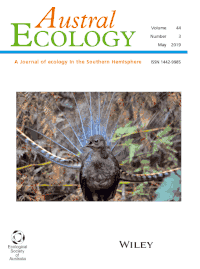Austral Ecology
Austral Ecology: A Journal of Ecology in the Southern Hemisphere is a peer-reviewed scientific journal covering research related to the ecology of land, marine, and freshwater systems in the Southern Hemisphere. It is published by Wiley and is the official journal of the Ecological Society of Australia. The journal addresses the commonality between ecosystems in Australia and many parts of southern Africa, South America, New Zealand, and Oceania. For example, many species in the unique biotas of these regions share common Gondwana ancestors. The journal was established in 1976 as Australian Journal of Ecology, obtaining its current name in 2000. As of 2017, the editor-in-chief is Nigel Andrew (University of New England, New South Wales, Australia).
 | |
| Discipline | Ecology |
|---|---|
| Language | English |
| Edited by | Nigel Andrew |
| Publication details | |
Former name(s) | Australian Journal of Ecology |
| History | 1976–present |
| Publisher | |
| Frequency | 8/year |
| 1.730 (2017) | |
| Standard abbreviations | |
| ISO 4 | Austral Ecol. |
| Indexing | |
| ISSN | 1442-9985 (print) 1442-9993 (web) |
| LCCN | 00252609 |
| OCLC no. | 928324250 |
| Links | |
The Michael Bull prize, named after a long-time editor, is awarded yearly for the best student-led paper published in the journal.
Manuscript types
The journal publishes the following article types:
- Invited Reviews
- Reviews
- Research Articles
- Research Notes
- Forum
- Ecological Toolkit
- Natural History Notes
Editors-in-chief
The following persons are or have been editor-in-chief of the journal: [1][2]
- D.J. Anderson (1976-1978)
- R.L. Kitching (1979-1981)
- I.R. Noble (1982-1984)
- A. Butler, H. Heatwole, R.J. Whelan (1985-1987)
- M. Bull, D. O'Dowd, R.J. Whelan (1988-1989)
- M. Bull, P. Fairweather, D. O'Dowd (1990-1992)
- D. Ayre, M. Bull, J. Ludwig (1993)
- M. Bull, P. Fairweather, J. Ludwig (1994-1995)
- P. Fairweather, J. Ludwig, S. McIntyre (1996)
- M. Bull, J. Landsberg, S. McIntyre (1997)
- M. Bull (1998-2017)
- N.R. Andrew (2018-present)
Abstracting and indexing
The journal is abstracted and indexed in:
- AGRICOLA[3]
- Biological Abstracts[4]
- BIOSIS Previews[5]
- CAB Abstracts[6]
- Current Contents/Agriculture, Biology & Environmental Sciences[5]
- EBSCO databases[7]
- GEOBASE[8]
- ProQuest databases[7]
- Science Citation Index[5]
- The Zoological Record[5]
According to the Journal Citation Reports, the journal has a 2017 impact factor of 1.730.[9]
References
- "A brief history of the Society". Ecological Society of Australia. 2012-05-14. Retrieved 2019-06-15.
- "Austral Ecology". Wiley Online Library. Retrieved 2019-06-15.
- "Journals Indexed in AGRICOLA". AGRICOLA. United States National Agricultural Library. Retrieved 2019-06-17.
- "Biological Abstracts - Journal List". Intellectual Property & Science. Clarivate Analytics. Retrieved 2019-06-17.
- "Master Journal List". Intellectual Property & Science. Clarivate Analytics. Retrieved 2019-06-17.
- "Serials cited". CAB Abstracts. CABI. Retrieved 2019-06-17.
- "Austral Ecology". MIAR: Information Matrix for the Analysis of Journals. University of Barcelona. Retrieved 2019-06-17.
- "Content/Database Overview - GEOBASE Source List". Engineering Village. Elsevier. Retrieved 2019-06-17.
- "Austral Ecology". 2017 Journal Citation Reports. Web of Science (Science ed.). Clarivate Analytics. 2018.